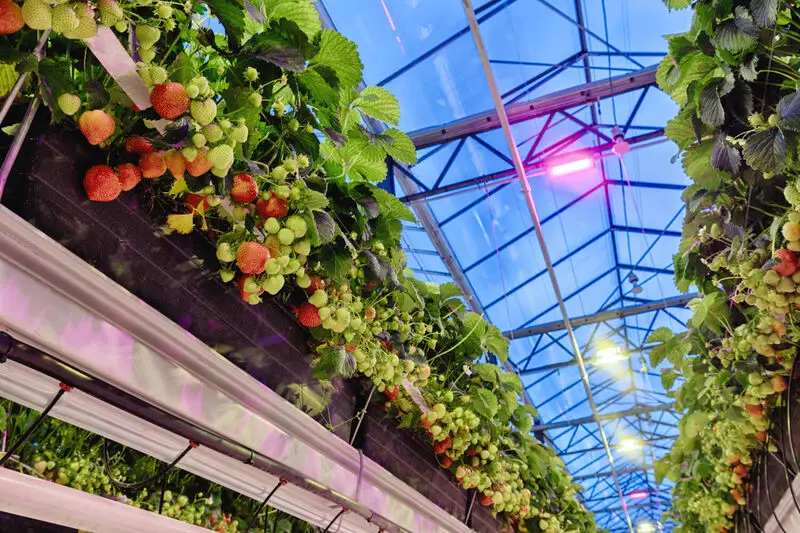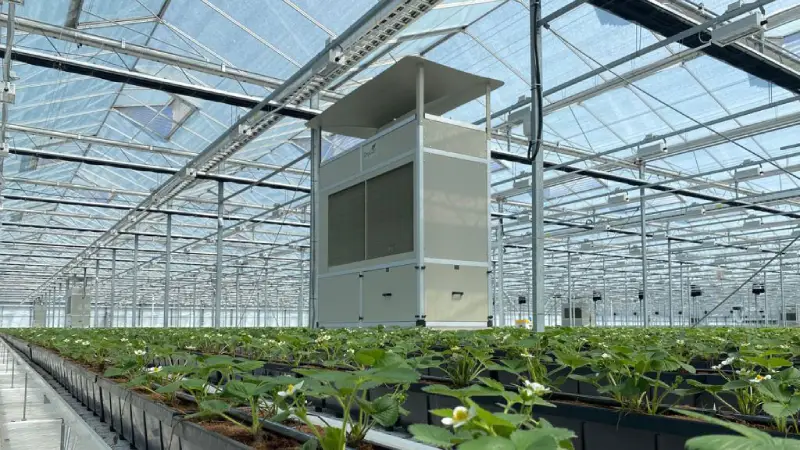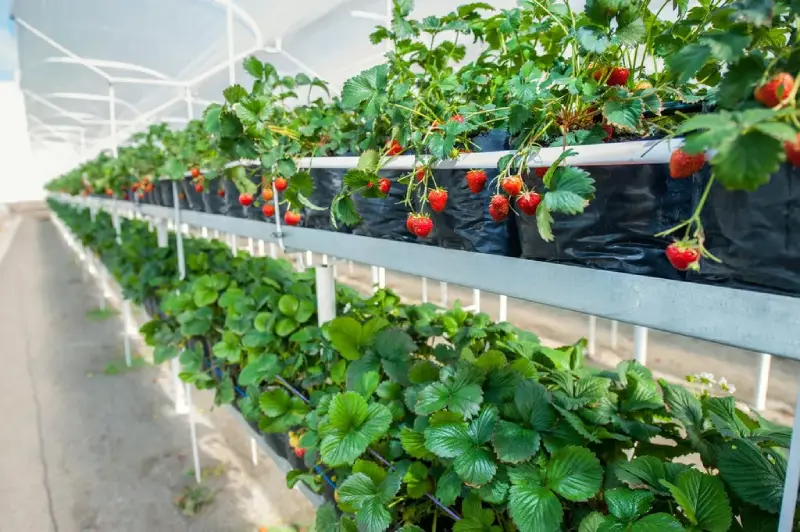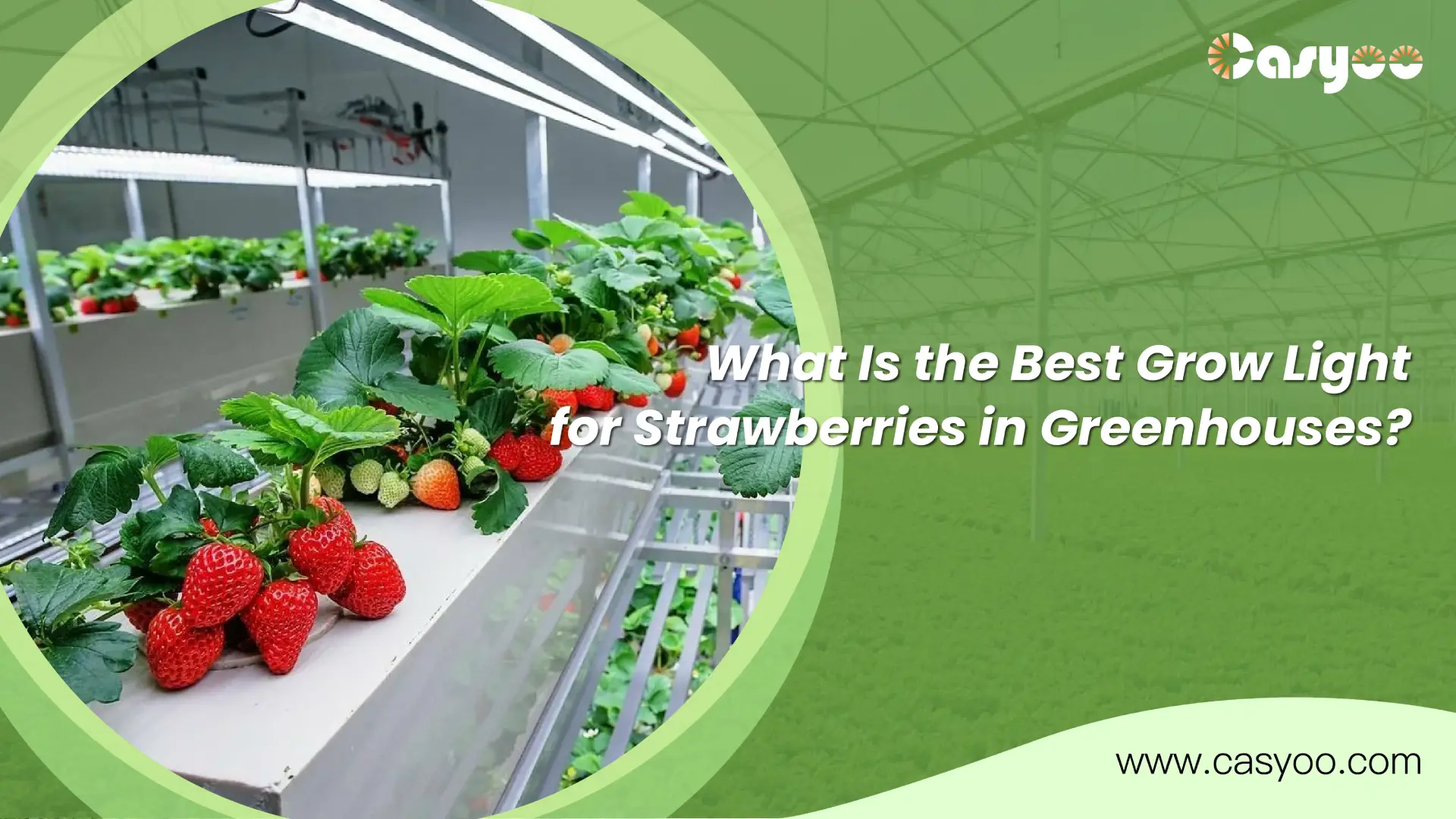Lighting is a key factor in increasing the quality and yield of strawberries. Insufficient light not only affects the normal growth of strawberries but also directly affects the temperature, humidity and carbon dioxide concentration in the greenhouse. In winter, the temperature is low, the light time is short, and the bad weather plus the greenhouse film itself will block part of the light, and the dust falling on the film will affect the light transmittance. Consequently, the light intensity in the greenhouse is less. So artificial lighting is necessary. Then, what is the best grow light for strawberries in greenhouses?
What are the ways to supplement light?
Traditional supplemental light
When choosing a greenhouse film, you can use high-quality drip-free film, which can increase the light transmittance of the greenhouse, while keeping the film clean, so as to maintain good light transmittance and increase light intensity. Some cultivation techniques can also improve the lighting conditions in the greenhouse. For example, strawberries are cultivated in a north-south direction, with large and small row spacings, so that each row can get better lighting conditions. You can also cover the ground film or hang reflective curtains, which reflect light energy and can enhance the reflected light and scattered light near the ground by 50% to 70%.
Artificial supplemental lighting
Artificial supplemental lighting is the use of artificial light sources to simulate the effective wavelength of sunlight for plants, promoting plant photosynthesis and other physiological functions. There are currently three main types of light sources. We will compare these light sources later.
Which artificial light should I use for greenhouse strawberry cultivation?

There are several different types of lighting systems when it comes to greenhouse strawberry cultivation.
Fluorescent grow lights
They are an old but reliable lighting system. If your plants receive enough light, you can use them alone. They can also be used as supplemental light like LED grow lights.
Fluorescent lamps do not emit a lot of heat, but their lighting range is short and only works at a distance of 12 inches. They do not use a lot of electricity, and when placed close enough to the strawberry plants, they produce a lot of light. This type of lighting system requires a lot of fans. Some new types of fluorescent lamps use higher levels of lumens to create better illuminations for your plants.
HPS grow lights
HPS lights are considered a fairly efficient light source in terms of efficiency. They give off an intense light. But they run at a much higher temperature than other grow lights. So they require more investment in cooling equipment. In addition, they require reflectors, ballast bulbs, and sockets, and their lifespan ranges between 12,000 and 24,000 hours.
LED grow lights
Although the price of LED lighting may seem higher than other types of lighting systems at first, they come in different types of systems and have many benefits. They do not produce as much heat as traditional ones. Due to their close location to the crops, less light is wasted. One can even use smaller LED bulbs around the plants without burning them. This makes them a great supplemental lighting to large grows or small indoor gardens.
LED grow lights have higher PAR values than other light sources. While HPS are also efficient, they emit a higher heat, which can result in less berry yields. What’s more, LED lights usually come with a built-in timer. This saves you the trouble of frequently turning the lights on and off manually. The most prominent advantage of LED is that it emits full-spectrum white light, which can provide your strawberries with the necessary spectrum from seedlings to fruits, promoting vigorous growth.
How long should grow light be on for strawberries?

Strawberries are light-loving plants, but they are also shade-tolerant. Insufficient light or continuous rainy weather often leads to weak plants, slender stems and leaves, thin and light leaves, poor pollination, falling flowers and fruits, and deformed fruits. However, the requirements for light in different growth stages of strawberries are different, and sometimes even opposite. For example, short days are required during the flower bud differentiation period, and longer and better light conditions are required during the flowering and fruiting stage. Let’s take a look at the requirements for light at different growth stages.
Seedling stage
At this period, everyone is most concerned about how to promote the growth of runners. During the seedling period, runners are prone to occur under long-day conditions. Longer lighting time is conducive to the occurrence of runners. Therefore, in order to promote the growth of runners during the seedling period, the daily lighting hours should be maintained at 12-16 hours.
Flower bud differentiation period
The requirements for light are relatively strict. Strawberry flower bud differentiation requires low temperatures and short daylight. Low temperature (17℃) and short daylight (10 hours) treatment can induce strawberries to enter flower bud differentiation early. Low temperature and short daylight treatment for about 15 days can allow strawberry seedlings to enter the reproductive growth stage from vegetative growth early. If the lighting time is too long, flower bud differentiation will be delayed, the number of flowers will decrease, the quality of flower buds will decrease, and even flowering and fruiting will not be possible.
Flowering period
After the flower buds of strawberries differentiate, longer lighting time can promote flowering. If there is insufficient light, the pollen germination rate will begin to decrease, pollination will be greatly affected, and it is easy to cause poor flower and fruit setting and a large number of deformed fruits in the later stage.
Fruiting period
When the light is sufficient, the strawberries in the greenhouse will grow strong, the leaves are dark in color, the fruit has high sugar content, strong fragrance, large fruit, and can obtain higher yields. When the light is insufficient, the leaves are thin and large, the petioles and pedicels are slender, the single fruit weight is reduced, the taste is sour, the quality is poor, and physiological diseases such as stunted fruit coloring are prone to occur. Green fruit is highly likely to develop if there is persistently low temperature and inadequate light, particularly when the greenhouse’s temperature drops below 5°C.
Therefore, 12 to 14 hours of light duration is advised from flowering to fruiting stages.
How far should my light be from the strawberries?
The hanging height will vary depending on the growth stage of the plant. During the strawberry seedling period, the plant needs less light. This means that the lamp can be installed farther away, usually hanging 24-30 inches away from the plant, depending on the wattage of the lamp you choose. During the vegetative growth stage, the lamp can be gradually moved closer, and the hanging height can be reduced by 5-10 inches depending on the response of the strawberry. The height range can be between 18-24 inches. Be careful not to reduce the distance suddenly, but gradually reduce the height.
How to improve greenhouse lighting conditions?

The following are some ways to increase greenhouse lighting.
- Choose a greenhouse with a good structure, which can effectively reduce the number of pillars in the greenhouse and increase the light intensity.
- Select a greenhouse film that drips well and has a high light transmittance.
- Keep the greenhouse film spotless to avoid dust and water droplets sticking to it. This step can increase the light by 30-50%.
- Lay silver ground film to enhance the light intensity between plants.
- Under the condition of ensuring the temperature in the greenhouse, appropriately open the curtain earlier and delay covering the curtain at night to extend the lighting time.
- Reflective film can be hung on the back wall of the strawberry shed, which can significantly enhance the light on the north side of the shed and enhance the photosynthesis of plants.
Finally, disastrous weather such as strong winds, cooling, rain and snow, extremely low temperatures, etc., have a great impact on strawberry planting, which can easily cause a reduction in yield or even a total loss of yield. Therefore, we should pay more attention to local weather forecasts and keep abreast of the forecasts of disastrous weather in time to reduce the losses caused by disasters.
Final thoughts
Light affects the growth, development, morphology, and material accumulation of strawberries, mainly through light quality, light intensity, and lighting time. There are three main types of light sources for strawberry growing: LED, HPS, and fluorescent lamps.
The best light to use on strawberries is an LED full-spectrum grow light. It ensures that the plant receives all the spectrum it needs for uniform and healthy growth. Grow with our full-spectrum grow lights for healthier and bigger strawberries right now!




